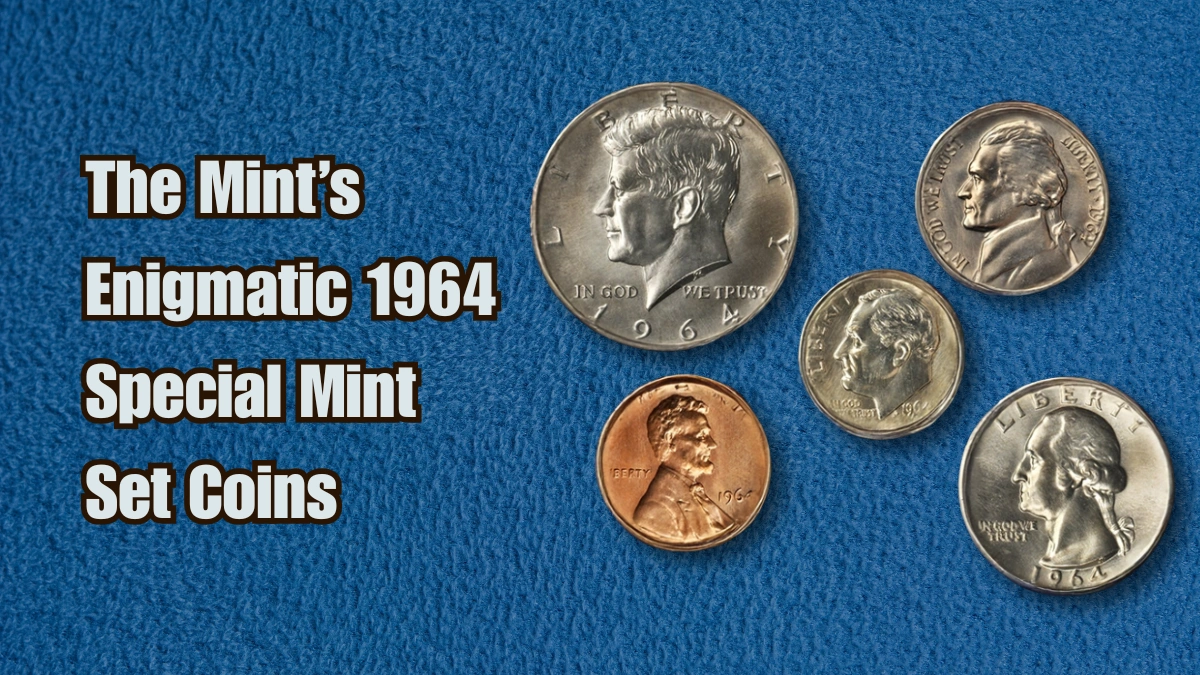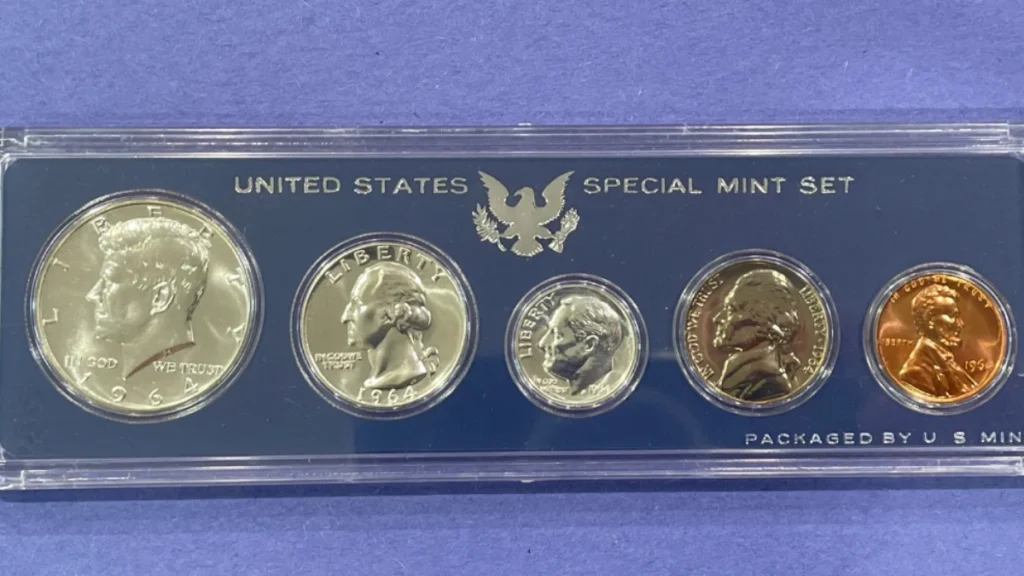
When people talk about “mystery coins,” the 1964 Special Mint Set (SMS) coins almost always come up. Rare, unusual, and with one of the most intriguing backstories in modern U.S. coinage, they’re often confused with the common 1964 Proof Sets or the Special Mint Sets of 1965–1967. But these coins stand apart—special trial strikes, not Proofs, and not regular Mint Sets.
Their origin is mysterious, and with only an estimated 15 to 50 sets ever struck, they were never released to the public. Still, they shed light on the mid-1960s coinage crisis, when the Mint struggled with silver shortages and soaring collector demand. Understanding them gives us insight into how the Mint adapted during that turbulent period.
Why Were 1964 Special Mint Set Coins Made?
In 1964, the country faced a coin shortage. People were hoarding silver dimes, quarters, and halves as silver’s value neared face value, while vending machines pulled coins from circulation faster than the Mint could replace them. At the same time, millions of Proof and Mint Sets were being bought each year, which officials believed worsened the shortage.
To cope, the Mint experimented with a new type of coin: a single-strike, high-quality piece easier to produce than Proofs but still appealing to collectors. Many researchers believe this experiment gave rise to the 1964 SMS coins. They were never intended for the public—likely made for internal testing or possibly presentation purposes.
The First Public Appearance and Discovery
For decades, no one outside the Mint knew these coins existed. That changed in 1991, when sets surfaced after the death of former Mint Director Eva Adams. Serving from 1961 to 1969, Adams oversaw both the Kennedy Half Dollar’s launch and the coinage crisis. Researchers now believe she retained these experimental pieces, which only came to light after her estate was auctioned.
This link to Adams ties the coins directly to Mint leadership during a pivotal era. By 1993, another set had appeared at a Stack’s auction, firmly establishing their existence.
Distinguishing SMS from Proof Coins
Side by side, SMS and Proof coins look different if you know what to watch for:
- Finish: Proofs have deep, mirror-like fields with cameo contrast. SMS coins have smooth, satiny, non-reflective surfaces.
- Strike: SMS pieces are razor-sharp with squared rims, struck under high pressure but usually only once. Proofs were struck multiple times.
- Overall look: SMS coins feel “special” but not flashy, sitting between circulation and Proof strikes. That’s why they’re classified as Specimen Strikes.
Were These Coins Ever Released to the Public?
No. Unlike mass-produced Proof and Mint Sets, the 1964 SMS coins never entered circulation or Mint sales. Estimates suggest only 15–50 sets exist, and nearly all trace back to Adams’ estate. The odds of finding one randomly are virtually zero.
Still, they reveal how the Mint experimented during the crisis years, testing methods to balance collector demand with urgent production needs.
The Coinage Crisis of the 1960s & The Date Freeze

By 1964, rising silver prices and widespread hoarding had pulled an estimated $460 million in coins from circulation. The Mint couldn’t keep up, and collectors were blamed for making things worse by locking away millions of sets each year.
As a response, Congress authorized a date freeze in September 1964. All coins struck afterward still carried the 1964 date, and mintmarks were suspended to discourage hoarding. While collectors were frustrated, the measure did little to stop silver hoarding. Still, this unusual step is tied directly to the story of the 1964 SMS coins.
The Coinage Act of 1965
The real solution to the coin crisis came with the Coinage Act of 1965, signed by President Lyndon B. Johnson. It removed silver from dimes and quarters and reduced the half dollar’s silver content to 40%. By debasing the coins, the government ended the incentive to hoard them for metal value. The Act also extended the date freeze and suspended mintmarks, giving the Mint breathing room to shift to new compositions.
This marked the end of 90% silver coinage, but the transition wasn’t immediate. The 1964 SMS coins fall right into that gray area—struck in silver as experimental pieces while the Mint prepared for the clad era.
The Transition to the SMS Program
In 1965, with resources stretched, the Mint suspended Proof and Uncirculated Sets. Instead, it introduced Special Mint Sets (SMS)—better than circulation coins but easier to make than Proofs. Produced from 1965–1967, they never gained much love from collectors. Even today, sets sell for only $10–$20.
That’s why the 1964 SMS coins matter: they were the prototype, the missing link between the silver Proof Sets of 1964 and the mass SMS issues of 1965–1967.
Theories on the 1964 SMS Coins
Numismatists generally point to two explanations:
- Trial Strikes – Made at Philadelphia in 90% silver, they likely served as internal tests to perfect SMS methods.
- Presentation Pieces – Possibly struck for officials or to honor the end of the silver era and the launch of the Kennedy Half. Their exceptional sharpness suggests they were never meant for mass production.
Whether trials or presentations, they remain rare insights into Mint experimentation.
Technical Nuances
The 1964 SMS coins are not Proofs. They were struck once under high pressure, giving razor-sharp details and squared rims but lacking the mirrored fields of Proofs. Instead, they show a satiny, brushed-metal finish.
Grading services classify them as Specimen Strikes (SP)—crisper than circulation coins, but distinct from Proofs.
Quick Comparison:
- Proofs: multi-strike, mirrored fields, cameo contrast.
- 1964 SMS: single-strike, satin finish, squared rims.
- Mintage: millions vs. only 15–50 sets.
Discovery and Rarity
Collectors didn’t hear of these coins until the early 1990s, when sets surfaced from the estate of Eva Adams, Mint Director from 1961–1969. Her involvement explains their survival and links them directly to Mint leadership.
With only 15–50 sets believed to exist, rarity drives their market. Individual pieces can bring $8,000–$15,000, while the 1964 SMS Kennedy Half Dollar has reached six figures—most famously $156,000 in 2019.
Definitive Status in Numismatics
Experts agree: the 1964 SMS coins are Specimen Strikes, not Proofs or Mint State coins. They are transitional artifacts—the last silver strikes of the old era and prototypes for the new SMS program. Their connection to Eva Adams adds intrigue, proving they were intentionally preserved.
They’re not just coins. They’re snapshots of a Mint under pressure, balancing innovation with tradition. For collectors, they remain both elusive treasures and enduring symbols of one of the most fascinating chapters in U.S. coinage.
Frequently Asked Questions
How can I tell if I own a 1964 SMS coin?
Look for a satiny, non-reflective surface with razor-sharp details and squared rims. Regular Proofs from 1964 will have mirrored fields, while circulation coins lack the same sharpness. If you think you might have one, only a top-tier grading service like PCGS or NGC can confirm it.
Why are these coins so expensive compared to regular 1964 issues?
It all comes down to rarity. With only 15 to 50 sets ever believed to exist, these coins are thousands of times rarer than Proofs or circulation strikes. That scarcity, combined with their unique backstory, drives prices into the tens or even hundreds of thousands of dollars.
Are all denominations equally rare?
Yes, but some command higher premiums. The Kennedy Half Dollar is the star of the group, regularly setting records at auction. The cent, nickel, dime, and quarter are also rare, but their prices tend to be lower, though still in the five-figure range for high-grade examples.
Were any other experimental coins made during this time?
Yes. The Mint was experimenting with many things in the mid-1960s, including the ill-fated 1964-D Peace Dollar, which was struck but never officially released. These abandoned projects highlight just how much the Mint was testing and adjusting during the coinage crisis.
What should collectors know before buying one?
Authentication is key. Because of their high value, 1964 SMS coins should only be purchased if they are certified by a major grading service. Provenance also matters—most known examples can be traced back to Eva Adams’ estate, giving them a documented chain of custody.
Conclusion
The 1964 Special Mint Set coins are among the most fascinating and elusive issues in modern U.S. numismatics. They were never released to the public, never advertised, and never documented in Mint reports. Instead, they appeared decades later, quietly surfacing through the estate of Eva Adams, a Mint Director who oversaw one of the most turbulent periods in U.S. coinage history. What makes them extraordinary is the combination of technical quality, historical context, and extreme rarity.
These coins were struck in 90% silver, at a time when the Mint was preparing to abandon silver entirely in favor of clad compositions. They showcase experimental striking methods—sharp details, squared rims, and satiny finishes—that set them apart from both circulation strikes and Proofs. They are not just coins; they are snapshots of history. They embody the Mint’s transition from traditional Proofs to Special Mint Sets, from silver to clad, and from abundance to scarcity.
They are the physical evidence of an institution under pressure, adapting to economic realities while still trying to preserve something for collectors. For those lucky enough to own one, the 1964 SMS coin is more than a collectible—it’s a prize, a conversation piece, and a numismatic treasure. For the rest of us, its story is still rewarding, because it reminds us how even in moments of crisis, the Mint found ways to innovate and leave behind pieces of history worth cherishing.
